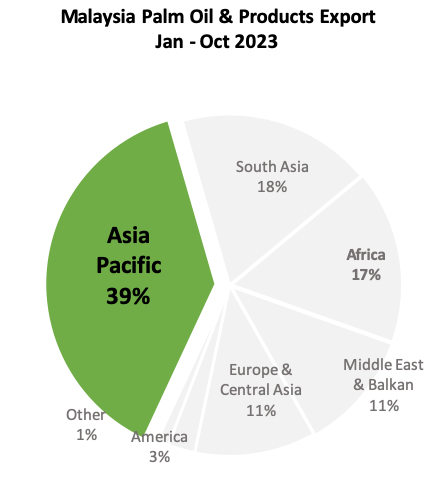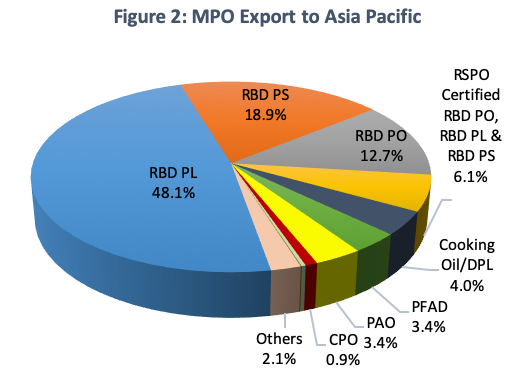ASIA PACIFIC REGION
Malaysian Palm Oil Exports Performance
(January – October 2023)
Regional Summary
In the Asia Pacific region, palm oil is the leading exported product, comprising 42.57%, equivalent to 3.26 million MT. Following this, palm kernel cake accounts for 20%, palm-based oleo for 14%, palm kernel oil for 3%, finished products for 1.7%, and biodiesel for 0.75%.

| Table 1: Malaysian Palm Oil and Palm Product Export to Asia Pacific | ||||
|---|---|---|---|---|
| Products | Jan – Oct 2023 | Jan – Oct 2022 | Change (MT) | Change (%) |
| Palm Oil | 3,268,599 | 3,566,080 | (297,481) | -8% |
| Palm Kernel Cake | 1,542,214 | 1,522,597 | 19,617 | 1% |
| Palm-Based Oleo | 1,042,890 | 1,033,670 | 9,220 | 1% |
| Palm Kernel Oil | 231,931 | 250,007 | (18,076) | -7% |
| Finished Products | 130,220 | 150,047 | (19,828) | -13% |
| Biodiesel | 58,863 | 47,792 | 11,072 | 23% |
| Other Palm Products | 1,402,169 | 1,492,742 | (90,574) | -6% |
| Total | 7,676,886 | 8,062,935 | (386,049) | -5% |
Featured Analysis
- The decline in Malaysian palm oil exports to China by 17.05% is primarily caused by intense price competition from Indonesia.
- From January to October 2023, Malaysia witnessed a substantial 43.66% increase in palm oil exports to Vietnam, rising from 262,760 to 377,491 tonnes, largely driven by the recovery of the tourism and food services sector.
- Palm oil imports in the Philippines have reached an 8-year low due to the deteriorating price competitiveness of palm oil, resulting in a partial shift in consumption back to coconut oil. According to Oil World, there is an overall decline in total vegetable oil consumption for the 2022/23 period in the Philippines. Additionally, the Philippines government is gearing up to raise its biodiesel mandate from 2% to 3% in the upcoming year. However, the proposed guidelines are foreseeing only coconut oil are used as feedstock under the mandate.
- Malaysia’s palm oil exports to South Korea increased by 13.87%, driven mainly by the cost competitiveness of palm oil over soybean oil, especially in industrial applications such as biofuel production. South Korea is projected to raise its biofuel mandate from 3.5% to 4.0% in 2024, which will require an additional 100,000 metric tons of feedstock. According to the United States Department of Agriculture (USDA), palm oil usage in biofuel is projected to witness a rise of around 50,000 metric tons if the 4% biofuel mandate is implemented.
ASIA PACIFIC
| Table 2: Malaysian Palm Oil Exports Performance in Asia Pacific Region | |||||
|---|---|---|---|---|---|
| Country | Jan-Oct 2023 | Jan-Oct 2022 | Diff (MT) | Diff (%) | |
| 1 | China | 1,137,902 | 1,371,814 | (233,912) | (17.05) |
| 2 | Japan | 456,445 | 448,024 | 8,421 | 1.88 |
| 3 | South Korea | 391,458 | 343,787 | 47,670 | 13.87 |
| 4 | Vietnam | 377,491 | 262,761 | 114,730 | 43.66 |
| 5 | Philippines | 345,744 | 563,269 | (217,525) | (38.62) |
| 6 | Taiwan | 207,348 | 176,064 | 31,284 | 17.77 |
| 7 | Singapore | 173,258 | 180,251 | (6,993) | (3.88) |
| 8 | Australia | 103,691 | 107,242 | (3,551) | (3.31) |
| 9 | Myanmar | 37,411 | 41,055 | (3,645) | (8.88) |
| 10 | New Zealand | 15,083 | 22,278 | (7,195) | (32.30) |
| 11 | Brunei | 7,762 | 6,846 | 916 | 13.37 |
| 12 | Papua N Guinea | 4,540 | 28,747 | (24,207) | (84.21) |
| 13 | Fiji | 2,618 | 3,092 | (474) | (15.33) |
| 14 | Hong Kong | 2,459 | 2,544 | (85) | (3.34) |
| 15 | Indonesia | 1,632 | 1,673 | (41) | (2.44) |
| 16 | Mongolia | 1,421 | 1,750 | (329) | (18.83) |
| 17 | Cambodia | 1,286 | 1,545 | (259) | (16.78) |
| 18 | Others | 1,052 | 3,338 | (2,286) | (68.84) |
| Grand Total | 3,268,599 | 3,566,080 | (297,481) | (8.34) | |
Source: MPOB
From January to October 2023, Malaysian palm oil export to Asia Pacific region decreased by 297,481 MT or by 8.34% to 3.27 million MT compared to the same period in 2022. The decline in Malaysian palm oil exports to this region increased from 152,621 MT between January and September to 297,481 MT between January and October period. The primary cause of the notable decline is observed by the decline in imports by China and the Philippines, as both countries experienced a collective drop of 451,437 MT. This decline was partially mitigated by an improvement in exports to Vietnam and South Korea, which witnessed a combined increase of 192,400 MT.
China remain as the biggest importer of Malaysian palm oil in the region with 1,137,902 MT of imports during the January to October 2023 period, decreased by 233,912 MT in comparison to the corresponding period last year. The major factor driving this decline is intense competition from Indonesia. Between January and September 2023, China imported 3.69 million MT of palm oil from Indonesia, marking a significant increase of 55.71% compared to the corresponding period in the previous year.
In October, Malaysian palm oil export to the Philippines continue to remain sluggish at 35,790 MT, dropped 25.33% from 47,930 MT same period of last year. For the period of January to October 2023, it recorded a steep decrease of 217,525 MT or by 38.62% to 377,491 MT. Likewise, Indonesia palm oil export to Philippines dropped 13.37% from 359,000 MT to 311,000 MT between January and September 2023. Palm oil imports in the Philippines have reached an 8-year low. Palm oil consumption in Philippines has suffered a setback as price competitiveness of palm oil has deteriorated. Therefore, consumption has partly shifted back to coconut oil. According to Oil World, there is an overall decline in total vegetable oil consumption for the 2022/23 period in the Philippines. Additionally, the Philippines government is gearing up to raise its biodiesel mandate from 2% to 3% in the upcoming year. However, the proposed guidelines are foreseeing only coconut oil are used as feedstock under the mandate.
It is also worth noting that from January to October 2023, Malaysia witnessed a substantial 43.66% increase in palm oil exports to Vietnam, rising from 262,760 to 377,491 tonnes, largely driven by the recovery of the tourism and food services sector. The primary palm products imported by Vietnam are RBD palm oil, RBD palm olein, and cooking oil, collectively contribute 93.89% of the total palm oil imports for the year. Vietnam primarily uses palm oil in food services and food processing sector because of its price competitiveness and functionality against other vegetable oil.
Between January and October 2023, Malaysia’s palm oil export to South Korea recorded a notable increase of 47,670 metric tons, representing a growth of 13.87%, totalling 391,458 MT. The 3 primary products exported to South Korea were RBD palm oil and RBD palm olein (195,167 MT), RBD palm stearin (120,812 MT), and PFAD (65,518 MT). These 3 products collectively accounted for 97.45% of the total palm oil exported to South Korea from January to October 2023. The improved palm oil imports by South Korea can be primarily attributed to the cost competitiveness of palm oil compared to soybean oil, particularly in industrial applications such as biofuel production. South Korea is projected to raise its biofuel mandate from 3.5% to 4.0% in 2024, which will require an additional 100,000 metric tons of feedstock. According to the United States Department of Agriculture (USDA), palm oil usage in biofuel is projected to witness a rise of around 50,000 metric tons if the 4% biofuel mandate is implemented.
Despite a year-to-date drop in exports, the total palm oil exports from Malaysia to the Asia Pacific region in the month of October amounted to 441,523 MT, an increase of 124,000 MT from the September export volume of 317,521 MT.
| Table 3: Breakdown of MPO Export to Asia Pacific Region | ||||
|---|---|---|---|---|
| PRODUCT | Jan-Oct 2023 | Jan-Oct 2022 | Diff (MT) | Diff (%) |
| RBD PL | 1,570,837 | 1,867,218 | (296,381) | (15.87) |
| RBD PS | 619,199 | 623,038 | (3,838) | (0.62) |
| RBD PO | 414,712 | 413,649 | 1,063 | 0.26 |
| RSPO Certified RBD PO, RBD PL & RBD PS | 199,674 | 159,271 | 40,404 | 25.37 |
| Cooking Oil/DPL | 131,573 | 162,330 | (30,758) | (18.95) |
| PFAD | 111,518 | 113,130 | (1,612) | (1.42) |
| PAO | 110,904 | 95,654 | 15,250 | 15.94 |
| CPO | 28,398 | 5,981 | 22,417 | 374.80 |
| CPS | 9,636 | 30,341 | (20,704) | (68.24) |
| CPL | 2,232 | 17,391 | (15,160) | (87.17) |
| Others | 69,916 | 78,078 | (8,161) | (10.45) |
| Total | 3,268,599 | 3,566,080 | (297,481) | (8.34) |

For more info please contact Mrs Rina Mariati
Email : rina@mpoc.org.my
*Disclaimer: This document has been prepared based on information from sources believed to be reliable but we do not make any representations as to its accuracy. This document is for information only and opinion expressed may be subject to change without notice and we will not accept any responsibility and shall not be held responsible for any loss or damage arising from or in respect of any use or misuse or reliance on the contents. We reserve our right to delete or edit any information on this site at any time at our absolute discretion without giving any prior notice.

